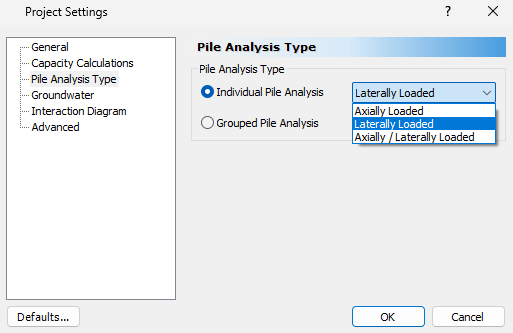RSPile
The RSPile support type in Slide2 works in conjunction with the Rocscience pile analysis program RSPile.
- Pile properties are defined in the RSPile program, which computes the mobilized lateral and/or axial resistance along the length of a pile, for a given soil geometry and loading conditions.
- The pile support force used in the Slide2 analysis is then determined by the location and angle of the slip surface intersection with the pile.
For a detailed example see Tutorial 30 - Analyzing Pile Resistance using RSPile. For information about RSPile click here.
RSPile File
If you have already defined properties and saved an RSPile file, then you can read in this file by selecting the Choose file  option.
option.
If you are defining a new RSPile file, then select the Run the RSPile Utility  option, to enter the pile and soil properties and save the file.
option, to enter the pile and soil properties and save the file.
For detailed instructions see Tutorial 30 - Analyzing Pile Resistance using RSPile.
Out of Plane Spacing
The spacing between soil nails in the out-of-plane direction (i.e. along the slope), measured from center to center.
Soil Displacement
The Soil Displacement is the allowable soil displacement along a slip surface at the point of intersection with a pile.
- Maximum - this allows you to enter a maximum (limiting) value of soil displacement
- Ultimate - in this case, the soil displacement is allowed to increase until the yielding of the pile
Force Application
For RSPile support, the default method of Force Application = Active. See the Force Application topic for a discussion of the significance of Active and Passive support force application in Slide2.
Axial and Lateral Analysis
Within the RSPile project settings, there are options to specify whether the pile will be considered to be Axially Loaded, Laterally Loaded, or Axially / Laterally Loaded.

If the pile is axially loaded, then the axial component of the soil displacement will be applied to the pile, and the axial reaction is applied onto the slip surface.
If the pile is laterally loaded, then the lateral component of the soil displacement will be applied along either the X’ and Y’ axis of the pile. The Lateral Shear Direction can be selected in Slide2 as either Along X’ in RSPile or Along Y’ in RSPile.
Batter and Ground Slope Modifiers
For certain materials, the batter angle and ground slope at the surface near the pile in the direction of slippage affect the ultimate soil resistance (see Laterally Loaded Piles Theory Manual in the RSPile documentation) calculated in RSPile.
Three options are provided in Slide2 to account for these angles:
- Apply Batter and Ground Slope Modifiers: If toggled OFF, angles will be ignored during calculations of ultimate soil resistance. Note that this can lead to an unconservative analysis in some cases. If toggled ON, then one of the following two options must be selected.
- Calculate from Slide2 model: the pile batter and ground slope angles that you have defined in the Slide2 model will be adopted during the calculation of the ultimate soil resistance.
- Use RSPile file values: the pile batter and ground slope angles in the RSPile file that you have selected will be adopted during the calculation of the ultimate soil resistance.